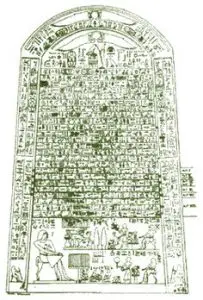The annual Egypt Passion Plays of Wesir or Osiris was celebrated at Abydos in Upper Egypt during the IV Akhet which was the period of the Inundation. In the modern calendar, this corresponds to the end of November. It was celebrated at least from the 12th Dynasty onwards.
About Egypt Passion Plays

The Ancient Egypt Passion Plays of Wesir at Abedjou, Ancient Egypt, was held in the last month of the inundation. These celebrations relied on the myth of the murder of Wesir by his brother Set, and also the way his sister-wife Aset managed to restore him to life again. The reason for them being held at Abedjou was that this was the traditional place where the body of Wesir drifted ashore after having been drowned in the Nile. The story of how his body was chopped up by Set and his helpers was a subsequent addition.
Though the exact procedures are largely unknown, yet it is believed that there were great celebrations among people combined with secluded, sacred rituals performed by the priesthood inside the temple. Part of these rites was, however, public and the processions which emerged from the temple were attended by masses of commoners. Perhaps the most important reason for the widespread popularity of the Cult of Wesir was the promise of eternal life to each and everyone, a commoner, and king alike.
Thousands of pilgrims from all parts of the Two Lands assembled yearly at Abedjou near the great temple to celebrate the mysteries. It was the desire and duty of every Egyptian to make a pilgrimage at least once in his life, to Abedjou.
Inside the temple enclosure, secluded rituals were performed, with the priests and god servants playing the parts of the different gods, and occasionally the King himself partook. The celebrations went back thousands of years, tradition bringing the sense of stability and eternity.
Some information of the proceedings of the Egypt Passion Plays of Wesir can be gleaned from a Middle Kingdom Stela, which describes how a high official by name of Ikhernofret is given the task by the King to organize the Festival processions.
The First Day – The Procession of Wepwawet:
Wepwawet opened the way of the procession. The enemies of Wesir were struck down in a mock battle. It seems an assault was staged by the ‘followers of Set,’ this assault was to be struck down, either by priests or by pilgrims acting the ‘followers of Wesir’, or perhaps by both. Likely it was acted out both on in the temple courtyards and outside, in the village streets. This could have been a way to commemorate the “Contendings of Horus and Set.”
The Second Day – The Great Procession of Wesir
The deceased Wesir, carried on a bark called ‘Neshmet’ which was a ‘night bark which Re rides in every night was taken from his temple to his tomb. The procession moves through the surrounding cemetery grounds to the tomb. The Lamentations of Aset and Nebt-Het were performed by women impersonating the goddesses.
There would be two women impersonating Aset and Nebt-Het, wandering around the temple premises and the village, looking for the body of Wesir. When they found him on the “riverbank”, they would sit down and recite the Lamentations.
During this night´s reenactment, the enemies of Wesir were slain on the ‘banks of Nedyet’ and the night ended with the trial of Set before the Divine Tribunal.
The Third Day – Wesir is Mourned and the Enemies of the Land are Destroyed
Mourning and weeping were continued. At the same time, there were probably secluded rituals in which a serpent and an ass, symbolizing Apep and Set, were destroyed, thereby making the country safe from their danger. It was not clear if these animals were offered as a fact, or if there were only statues of them.
The Fourth Day – Night Vigil
During the Night Vigil there were prayers and recitations performed before the statue of Wesir. Priests and priestesses played parts in the reenactment and actual funeral rites were also performed.
The Fifth Day – Wesir is Reborn
The god was reborn at dawn and crowned with the crown of Ma’at. The statue of Wesir on the Neshmet bark was brought back in triumph to his temple, followed by the jubilant masses. Purifications and re-installment of the god in his House followed and before the rites were concluded, the ritual of the ‘Raising of the Djed-pillar’ took place. This last part was, however, not open to the public.
When the festival was concluded, the pilgrims usually offered something to the god, something like dried alluvium, a small statuette, even a shrine or, if they were rich or kings, an entire temple. Many pilgrims also erected stela on the grounds or at the outer precincts of the temple to be able to witness the Mysteries also after they themselves had ‘Gone West.’